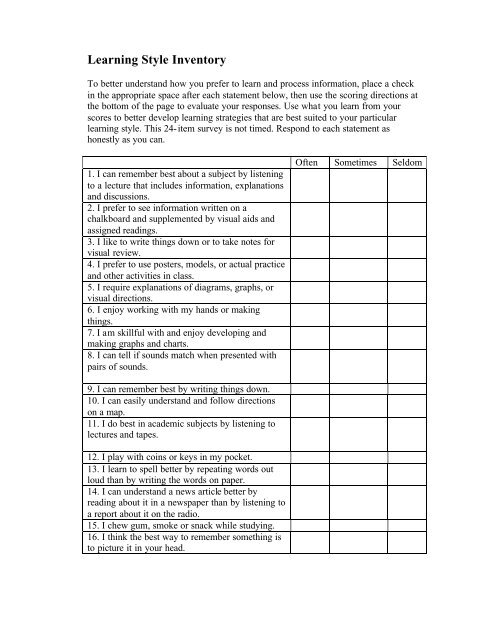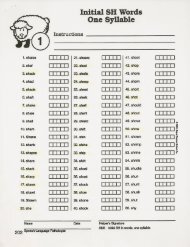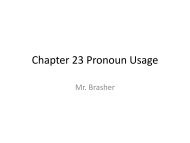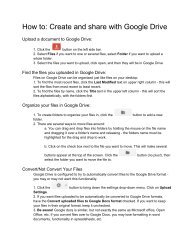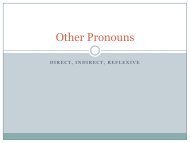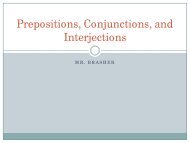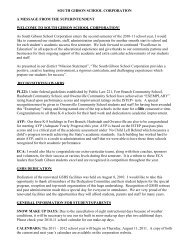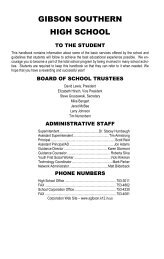Learning Style Inventory
Learning Style Inventory
Learning Style Inventory
- No tags were found...
Create successful ePaper yourself
Turn your PDF publications into a flip-book with our unique Google optimized e-Paper software.
<strong>Learning</strong> <strong>Style</strong> <strong>Inventory</strong>To better understand how you prefer to learn and process information, place a checkin the appropriate space after each statement below, then use the scoring directions atthe bottom of the page to evaluate your responses. Use what you learn from yourscores to better develop learning strategies that are best suited to your particularlearning style. This 24-item survey is not timed. Respond to each statement ashonestly as you can.1. I can remember best about a subject by listeningto a lecture that includes information, explanationsand discussions.2. I prefer to see information written on achalkboard and supplemented by visual aids andassigned readings.3. I like to write things down or to take notes forvisual review.4. I prefer to use posters, models, or actual practiceand other activities in class.5. I require explanations of diagrams, graphs, orvisual directions.6. I enjoy working with my hands or makingthings.7. I am skillful with and enjoy developing andmaking graphs and charts.8. I can tell if sounds match when presented withpairs of sounds.Often Sometimes Seldom9. I can remember best by writing things down.10. I can easily understand and follow directionson a map.11. I do best in academic subjects by listening tolectures and tapes.12. I play with coins or keys in my pocket.13. I learn to spell better by repeating words outloud than by writing the words on paper.14. I can understand a news article better byreading about it in a newspaper than by listening toa report about it on the radio.15. I chew gum, smoke or snack while studying.16. I think the best way to remember something isto picture it in your head.
17. I learn the spelling of words by “fingerspelling” them.18. I would rather listen to a good lecture orspeech than read about the same material in atextbook.19. I am good at working and solving jigsawpuzzles and mazes.20. I grip objects in my hands during learningperiods.21. I prefer listening to the news on the radiorather than reading the paper.22. I prefer obtaining information about aninteresting subject by reading about it.23. I feel very comfortable touching others,hugging, handshaking, etc.24. I follow oral directions better than writtenones.Scoring ProceduresDirections: Place the point value on the line next to the corresponding item below.Add the points in each column to obtain the preference score under each heading.OFTEN = 5 points SOMETIMES = 3 points SELDOM = 1 pointsVISUAL AUDITORY TACTILENO. PTS. NO. PTS. NO. PTS.2 1 43 5 67 8 910 11 1214 13 1516 18 1719 21 2022 24 23VPS = APS = TPS =VPS = Visual Preference APS = Audio Preference TPS = Tactile Preference
<strong>Learning</strong> <strong>Style</strong>s AssessmentRead each statement and select the appropriate number response as it applies to you.Often (3) Sometimes (2) Seldom/Never (1)Visual Modality______ I remember information better if I write it down.______ Looking at the person helps keep me focused.______ I need a quiet place to get my work done.______ When I take a test, I can see the textbook page in my head.______ I need to write down directions, not just take them verbally.______ Music or background noise distracts my attention from the task athand.______ I don’t always get the meaning of a joke.______ I doodle and draw pictures on the margins of my notebook pages.______ I have trouble following lectures.______ I react very strongly to colors.______ TotalAuditory Modality______ My papers and notebooks always seem messy.______ When I read, I need to use my index finger to track my place on theline.______ I do not follow written directions well.______ If I hear something, I will remember it.______ Writing has always been difficult for me.______ I often misread words from the text-(i.e.,“them” for “then”).______ I would rather listen and learn than read and learn.______ I’m not very good at interpreting an individual’s body language.______ Pages with small print or poor quality copies are difficult for me toread.______ My eyes tire quickly, even though my vision check-up is always fine.______ TotalKinesthetic/Tactile Modality______ I start a project before reading the directions.______ I hate to sit at a desk for long periods of time.______ I prefer first to see something done and then to do it myself.______ I use the trial and error approach to problem-solving.______ I like to read my textbook while riding an exercise bike.______ I take frequent study breaks.______ I have a difficult time giving step-by-step instructions.______ I enjoy sports and do well at several different types of sports.______ I use my hands when describing things.______ I have to rewrite or type my class notes to reinforce thematerial.______ Total
Total the score for each section. A score of 21 points or more in a modality indicatesa strength in that area. The highest of the 3 scores indicates the most efficient methodof information intake. The second highest score indicates the modality which booststhe primary strength. For example, a score of 23 in visual modality indicates a strongvisual learner. Such a learner benefits from the text, from filmstrips, charts, graphs,etc. If the second highest score is auditory, then the individual would benefit fromaudio tapes, lectures, etc. If you are strong kinesthetically, then taking notes andrewriting class notes will reinforce information.
Characteristics of <strong>Learning</strong> <strong>Style</strong>sThree of your senses are primarily used in learning, storing, remembering andrecalling information. Your eyes, ears, and sense of touch play essential roles in theway you communicate, perceive reality and relate to others. Because you learn formand communicate best with someone who shares your dominant modaility, it is agreat advantage for you to know the characteristics of visual, auditory and kinestheticstyles and to be able to identify them in others.Visual• Mind sometimes strays duringverbal activities• Observe rather than acts ortalks• Likes to read• Usually a good speller• Memorizes by seeing graphicsor pictures• Not too distractible• Finds verbal instructiondifficult• Has good handwriting• Remembers faces• Uses advanced planning• Doodles• Quiet by nature• Meticulous, neat in appearance• Notices detailsAuditory• Talks to self aloud• Enjoys talking• Easily distracted• Has difficulty with writtendirections• Likes to be read to• Memorizes sequentially• Enjoys music• Whispers to self while reading• Distracted by noise• Hums or sings• Outgoing by nature• Enjoys listening activitiesKinesthetic• Likes physical rewards• In motion most of the time• Likes to touch people whentalking• Taps pencil or foot whenstudying• Enjoys doing activities• Reading not a priority• Poor speller• Likes to solve problems byphysically working throughthem• Will try new things• Outgoing by nature; expressesemotions by physical means• Uses hands while talking• Dresses for comfort
SOUND: Hints for the Auditory LearnerGeneral1. Say aloud the information to be learned/have someone read the information toyou/read it into a tape recorder and replay it.2. Read your work out loud. Summarize what you have read on tape.3. Say words inside your head silently.4. Brainstorm ideas with others. Form study groups.5. When possible, learn information through tapes, television, oral reports, rhymesand songs, radio, lectures, book reviews, panel and group discussions, guestlectures, and oral questions and answers.6. Use a straight-edge marker or guide to assist you in keeping your place while youare reading or working with printed materials.7. Tape class lectures (Ask instructor for permission).8. Meet with classmates before and/or after class to discuss material.Writing1. Plan each sentence you want to write by saying it out loud or silently in yourhead.2. Say each sentence several times.3. Write each sentence as you say it, or talk into a tape recorder, dictating eachsentence of your paragraph; then play the tape back – one sentence at a time – andrecord your paragraph in writing.Spelling1. Listen to the spelling of the word.2. Say the word – then say each letter out loud3. Close your eyes and spell the word out loud; check your spelling.4. Close your eyes and spell the word out loud again; check your spelling.5. Now write the word, trying to hear it in your mind.6. Verbally review spelling words and lectures with a friend.Mathematics1. Learn math while saying the concept, fact, theorem, etc., aloud.2. Explain math problems, concepts, facts, etc., to yourself, relating the informationout loud.3. Use a tape recorder and replay the information.
SIGHT: Hints for the Visual LearnerGeneral1. Take notes, make pictures, graphs, and charts. Use flashcards and highlight keydetails2. Sit close to the teacher so that you can watch his/her face and gestures.3. Take notes or make lists as you listen to directions.4. Carefully check instructions written on the chalkboard and on handouts.5. as the teacher lectures, pay attention to visual aids such as the following:- Drawing, maps, graphs, charts- Transparencies, posters, films, books6. Imagine pictures of the information you are suppose to remember.7. Use color coding as cues to important information.8. When possible, read assignments silently.9. Maintain class notes and outlines of important information to study.10. Try to read and study in well lit, quiet place.11. Record homework assignments in a date book, on a note pad, or a speciallydesigned assignment sheet.12. Keep a note pad with you at all times. Write out everything for frequent and quickvisual review.Reading1. Use sight words, flashcards, note cards and experience stories; don’t try to soundwords out, but try to determine if the new word or words has words you alreadyknow. For example, the “systematic” has the word “system”, “stem” and “mat”within it.2. You are a “look-and-say” learner. Look at a word carefully; then say it.Writing1. Jot down ideas as they form in your mind.2. Outline your ideas.3. Make a rough draft, skipping lines. Correct/revise your work.4. Re-coy your paper.5. ESSAY TEST: Make quick outlines on scratch paper or in the margin of the testbefore writing your answer.Spelling1. See the word – close your eyes.2. Make a picture – then read from your picture.3. Write the word – match the picture.4. Check your work immediately.Mathematics1. Visualize the problem.2. Make pictures or tallies of the problem on scratch paper.3. Write the problem.
TOUCH: Hints for the Tactile/Kinesthetic Learner1. Keep your desk clear of distracting objects.2. Cover the page you’re not reading3. If you are distracted by noise, turn off the radio; wear earplugs or wear anearphone in the learning center to block out the noise. If you want sound, listen tosoft music.4. Divide your work into short study sessions. Get a timer. After 20 minutes or whena task is completed, give yourself a reward, a cookie, a wlak around the block,listen to one song, etc.5. Sit as close to the teacher as possible, or sit in the center of the room by quietstudents.6. When studying, use a multi-sensory approach (hearing, seeing, touching anddoing) as much as possible.7. Get plenty of sleep.8. Eat a nutritious breakfast and lunch. Snack on fruit or nutritional food if you needextra energy.9. Study in a carrel or in an office where there is a desk for your text books andnotebook.10. Use models, real objects, and materials that can be touched and moved. Forexample, learn geography through handling and studying a globe.11. When possible draw what you are learning.12. Trace spelling words as you practice them.13. Record in writing information learned. Keep a supply of paper on hand.14. When possible, role play, type, take notes, or construct models to learn theinformation.


